Have you ever thought about growing edibles in water?
As someone who hates watering in summer, growing in water is a game-changer for us. It’s like having a ‘self-watering’ pot which grows moisture-loving plants with no effort on your part, just place and forget.
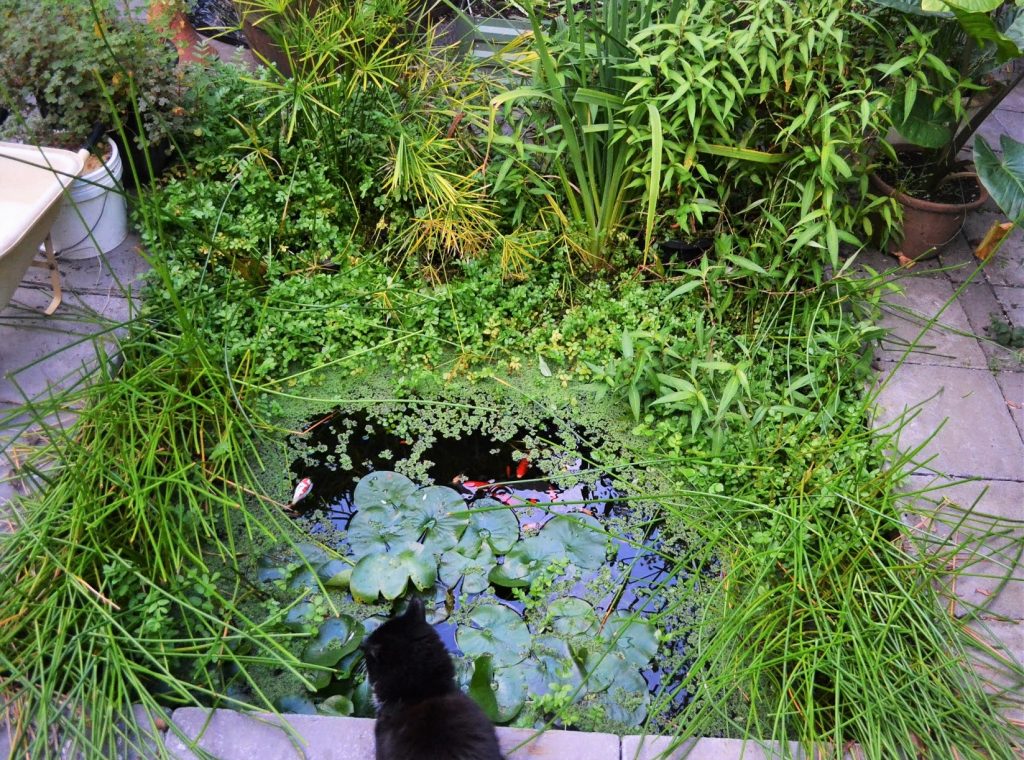
But I’ve only got a small space…?
Don’t worry, you don’t need a big space at all to harness the benefits of growing in water. The simplest set up just uses a bucket, or a large flexi-tub you can buy from the hardware store or find in hard rubbish. I have successfully grown watercress and kang kong (water spinach) in those white 10L buckets that you get from cafes.


If you were to go larger, you could use a small water feature, an old bath tub or wheelbarrow, or a small pond as we have. Or pond is around 2m x 2m square and around knee deep. We also have a smaller water feature in the front yard.
Benefits of growing in water
There are so many benefits to growing in water. Some of our favourite reasons are:
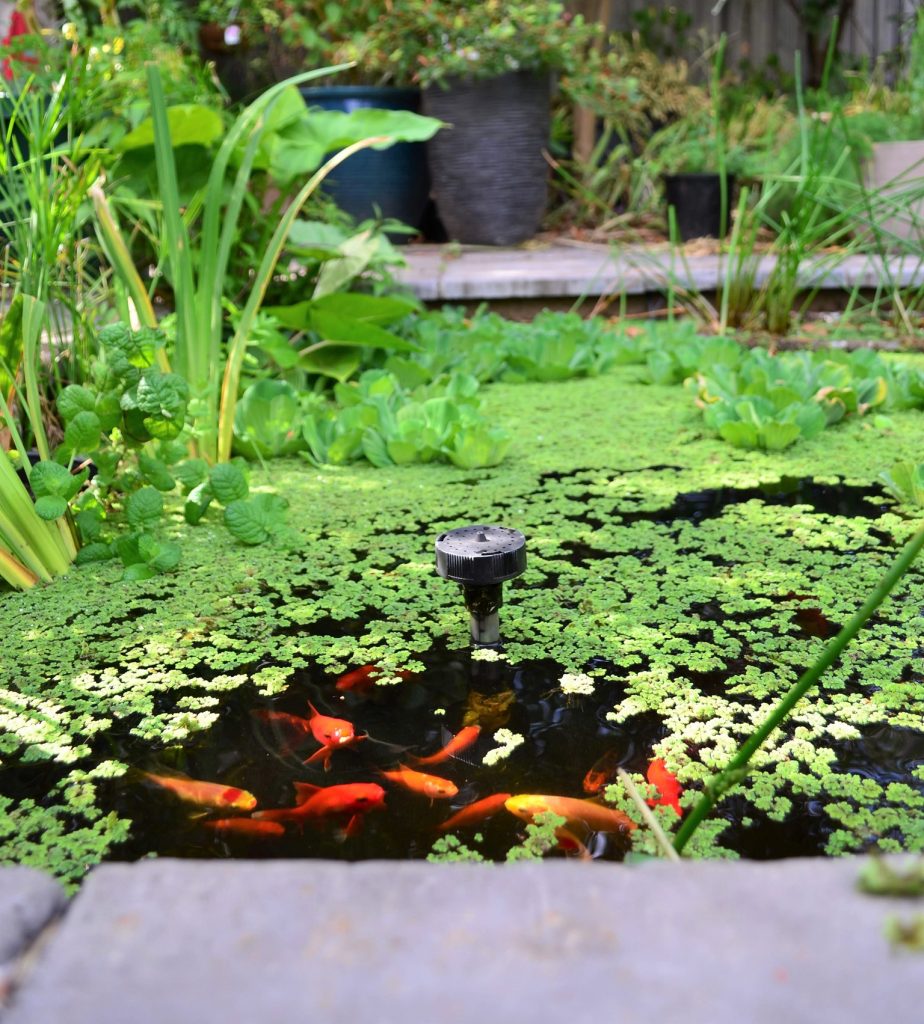
- No regular watering required – in our scorching desert-like summer, this is a huge advantage. It means our pond plants are always lush and green, as they have a reservoir of water to draw on as needed. Most years we don’t need to top up the pond at all. If you are growing in a smaller bucket you may need to top up with water a little more, but this will be far less often than your standard garden bed. In this way, a pond works in a similar way to a wicking bed
- Growing delicious water-loving plants – watercress, mints and water chestnuts all love water. Growing in water allows you to grow these fast-growing and nutritious plants on a backyard scale. You can go on holiday and not worry about them due to their constant water source. If you have fish in the pond their poo will also provide a source of fertiliser for the plants.
- Insects love it – nothing in our garden attracts more bees than our pond. In summer, it is visited by a never-ending stream of bees, dragonflies and other beneficial insects. And growing surface plants help insects to drink from the pond without falling in. After having a drink, they may also hang around longer, pollinate some flowers, lay their eggs – this helps you to attract beneficial insects to your yard.
- Having a water feature creates a unique microclimate in your garden – bodies of water help to cool the garden in summer by releasing moisture which provides humidity for plants and cools the air; while in winter, water stores up warmth which is released at night. The area around the pond becomes a micro-climate to temper extreme temperature changes.
- A pond can provide you with endless free-fertiliser and help you close the waste loops – and no you don’t need to eat your fish! Our fish poo provides the nutrients to feed our plants which then feeds us. It also grows azolla which is a fast growing and nutrient rich fertiliser (more on that below).
- And finally, because water is pretty and relaxing! Water, fish and a fountain provide a visual focal point in the garden and create a wonderful place to sit beside and just watch the fish swimming around.
Ok… but what about mosquitos?
I am one of those people that mosquitos love – they will sidestep, avoid, dodge my partner just to seek me out. Something about sweet blood, or eating too many avocados??? We all know mosquitos lay their larvae in water – so one of the most common questions I’m asked is how do you deal with all the mosquitos?
My answer is fairly simple: fish and azolla
- Fish will eat mosquito larvae and take care of the problem for you – this also provides a sustainable food source for the fish which need very little additional feeding.
- Azolla is a floating surface plant that deters mosquitos from laying their eggs. Particularly useful where you don’t want to keep fish or your pond is too small for fish. It’s other name is “mosquito fern”. I will discuss this more under our favourite plants section below.
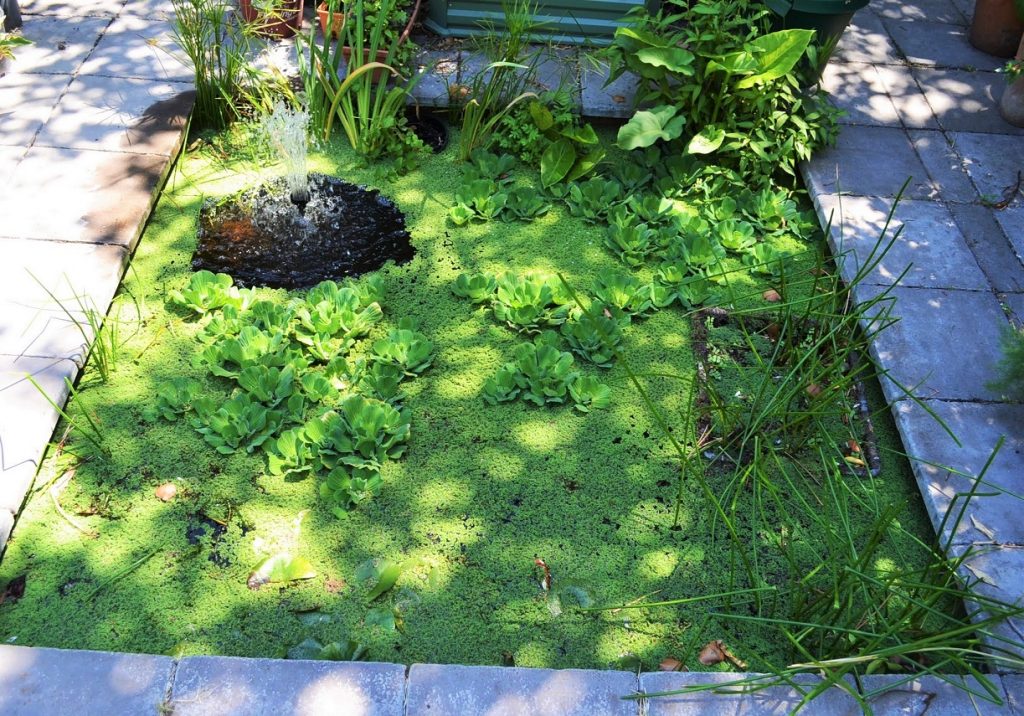
How to create a healthy ecosystem in your pond – our journey and struggles
Our algae and stress-filled pond
When we first started, our pond was always a green cesspool filled with algae. No matter how many times we changed the water the algae would come back. After a water change, it would look good for around a month and then quickly turn soupy green again. This was an ordeal in and of itself, as we’d have to stand knee deep in cold algae filled water, scoop it all out bucket by bucket and scrub the sides – all the while ensuring we didn’t harm any fish. Imagine the work it takes to clean a small aquarium and multiply that by 100. I can safely say no one looked forward to pond cleaning time, which would come around all too often!
Eventually, we sought advice from a pond store.
- We were first told to cull our fish “you have too many” for your space – by this time our fish population had multiplied to around 20. No we did not follow this advice to get rid of our fish.
- We were also told, your pond is in a location that is too sunny which causes the algae to grow – the only fix being to buy a UV filter. Again we weren’t keen on this, as a UV filter is expensive, would need to be run constantly and waste considerable power, and would also simultaneously kill off any good bacteria in the pond.
- We’d also contemplated getting rid of the pond altogether as it was just too much work – but this seemed like a waste and there had to be a better way.
We got so desperate we ended up buying some ‘algae tablets’ from the pond store which were marketed to us as a cure all. They were simple and inexpensive, just drop a few tablets into the pond each year and you’d be guaranteed to have crystal clear water. And yes it did work, our water was crystal clear magically within a few weeks, and all the algae was gone. I’ve never seen the water so clean! But as we all know, anything too good to be true usually is. Not long after, the few plants we had in a pond – our water lily and water lettuce – started to wilt and rot. I tried to salvage them but some didn’t make it. In the same way the tablets killed the algae, they must’ve also affected the other plants. I later read online the tablets could also harm fish, even though we were assured they wouldn’t – fortunately ours weren’t affected! I couldn’t accept that this was the only way forward – it was not sustainable and was forcing us to choose between having pond plants or have putrid green water.
Our solution to a healthy and sustainable pond
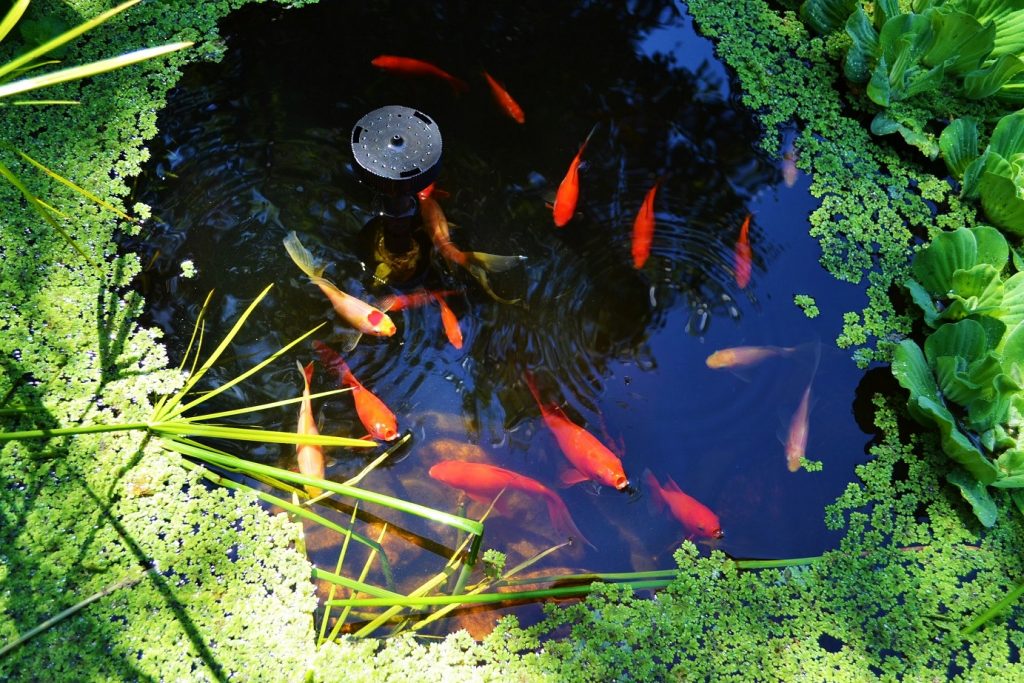
I thought there had to be a better and sustainable way, without sacrificing fish or using chemicals. I researched – borrowed every book on the subject, joined forums and pestered it with comments and did lots of reading. I finally found a seemingly simple solution – which was to completely fill the pond with a diversity of plants. Algae in the pond was a signal that there is an excess of nutrients. By filling the pond with plants, the plants will soak up the excess nutrients, filter the water and prevent the algae from growing. Could it really be this simple?
And yes it was! Over time, we gradually purchased more and more plants, and filled our pond with plants both above, on and under the water.
- We divided up our single lily into 4 plants, planted many more plants both above and below water (which we discuss below).
- Most importantly, we managed to source a large batch of azolla (which you can see covering the surface of our pond in the photos). The azolla floating on the surface was integral to this solution – ensuring at least 40% of the surface of the water was covered with plants prevents excessive sunlight getting in and the algae growing.
- Over time we also added in a variety of edible plants into the pond in order to expand our edible foodforest.
We now have over 30+ fish, never run the pond pump or fountain, and there is very little regular work – yet we always have clear water. We are so pleased we have finally found a sustainable solution to our green pond problem, which not only provides food and free fertiliser for us – but also the host of other benefits of having a pond in your garden.
Our list of must-have plants to grow in water
1. Azolla – an absolutely essential pond and permaculture plant, particularly if you have goldfish. Azolla is a fast grower and consumes all the nutrients produced by the fish, thereby depriving algae of any food to grow. It also covers the surface of the water and prevents the sun from getting in (sunlight promotes algae growth).
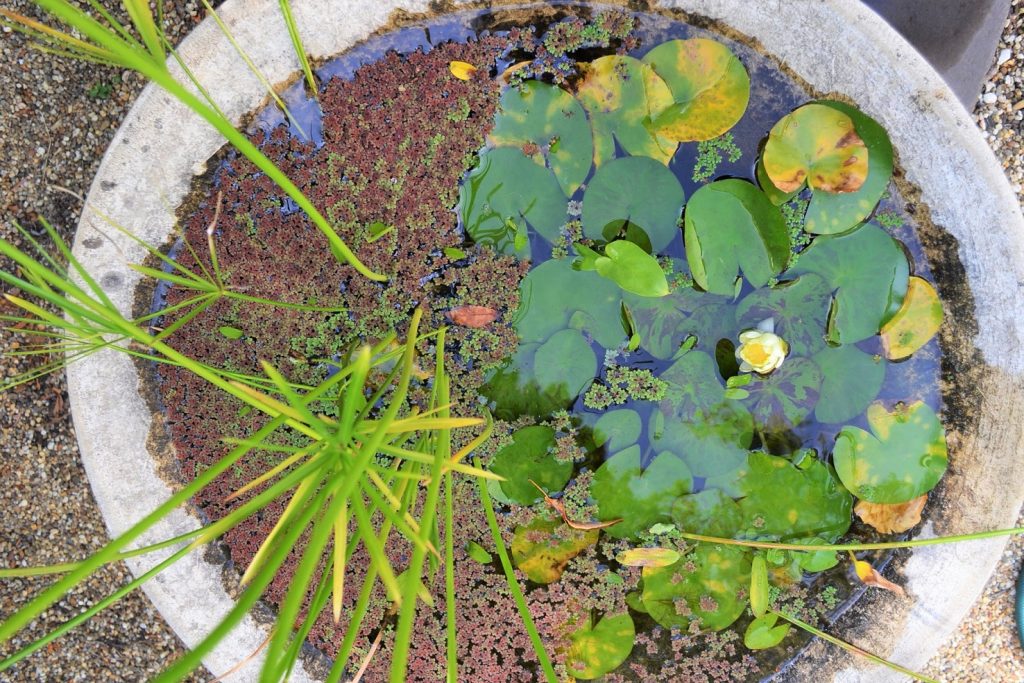
The recommendation is to have at least 40% of your pond surface covered by plants. In our sunny spot in summer, I usually aim for around 80-90% coverage. Azolla is a super fast grower and also has the benefit of fixing nitrogen from the atmosphere.
You will however need to stay on top of the azolla as it’s so fast growing – in summer you might need to scoop some out every week. It is a compost accelator, rich source of mulch and fertiliser – simply scoop out and place on your garden bed. It is also a great fish and animal (including chicken) food. Also ensure that it doesn’t get into waterways, as it can be invasive in certain areas.
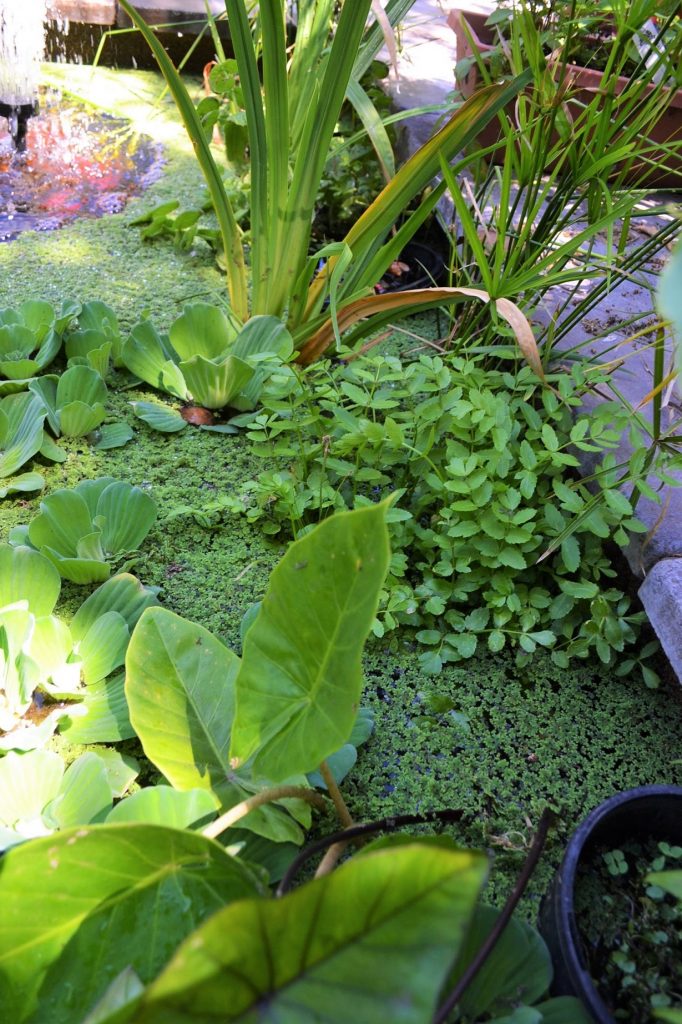
Azolla can be a smart idea even if you don’t have any fish. Its common name is ‘mosquito fern’, which is a reference to the fact that, when it covers the surface of a water, mosquitos are unable to lay their eggs in the water! Is there anything this plant can’t do?! Anything that stops mosquitos in the garden is always going to be a favourite of mine! The azolla has single-handedly transformed our pond into an ecosystem: the azolla grows rapidly by drawing out the nutrients in the excess of fish poo we have -> we then add buckets of azolla to compost -> our compost feeds our fruit and veggie plants -> that in turn feed us.
As the co-founder of Permaculture Bill Mollison once said: “you don’t have a snail problem, you have a duck-deficiency“. In our case, our problem wasn’t an overabundance of fish but a deficiency of azolla and other pond plants.
2. Other ornamental plants that provide surface coverage, such as water lily and water lettuce – these look so pretty in the pond, and are also practical as they shield the water from excess sunlight and provide a platform for bees to drink from.
Water Lily – Nothing beats the glowing bright pops of colour of water lily. They produce stunning flowers in summer ranging from white, creamy to pinks and purples. They are so calming in a pond. Their giant leaves also shield the pond from excess sunlight and provide an attractive drinking station for bees, dragon flies and other beneficial insects. Water lilies are perennial plants so will come back year after year. They go dormant in winter and re-emerge in spring. Water lilies need to be divided up every few years in order to keep flowering at their best.
Water lettuce grows so fast that it’s even outcompeted our azolla! I got one plant and, four months later had 30 in a particularly hot summer season. They grow from little babies that break off and form their own families. However they are a true tropical plant and will not survive areas with winters, so treat as an annual in cooler areas. Be sure to remove them as you head into winter, and you can tell that they’re starting to ‘dissolve’ – leaving them in the pond will affect your water quality.
3. Edibles – we love growing food in water, it is both easy and delicious. How else can you experience the taste of fresh, crispy water chestnut?
TIP: if your pond is too deep, sit your plants in pots up on a few bricks, plastic tubs or whatever you have to provide a platform for the plants.
- Mint – Believe it or not, mint does not grow well in our native soil. Our garden is too sandy and dry, and mint being a bog plant never thrives in our garden in summer. In the pond, our mint flourishes with no effort. We successfully grow many varieties, including apple mint and peppermint. I also grow Vietnamese mint.
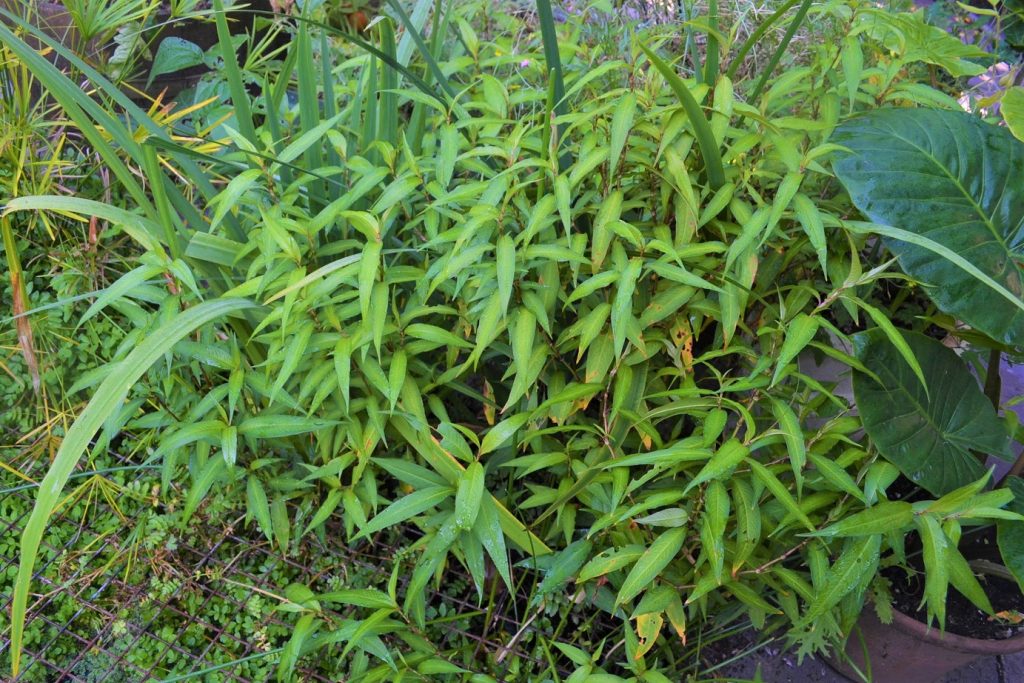
- Watercress – as you might guess, watercress loves water. I’m growing two types: standard sandwich watercress (peppery and often touted as a superfood) and Lebanese watercress (which has lovely fern like leaves). Lebanese watercress is often marketed as ‘carrot plant’, as it has a distinct carroty taste – it adds a wonderful pop of flavour to any salad or stir fry. With watercress you’ll never go hungry as it grows so prolifically in the pond.


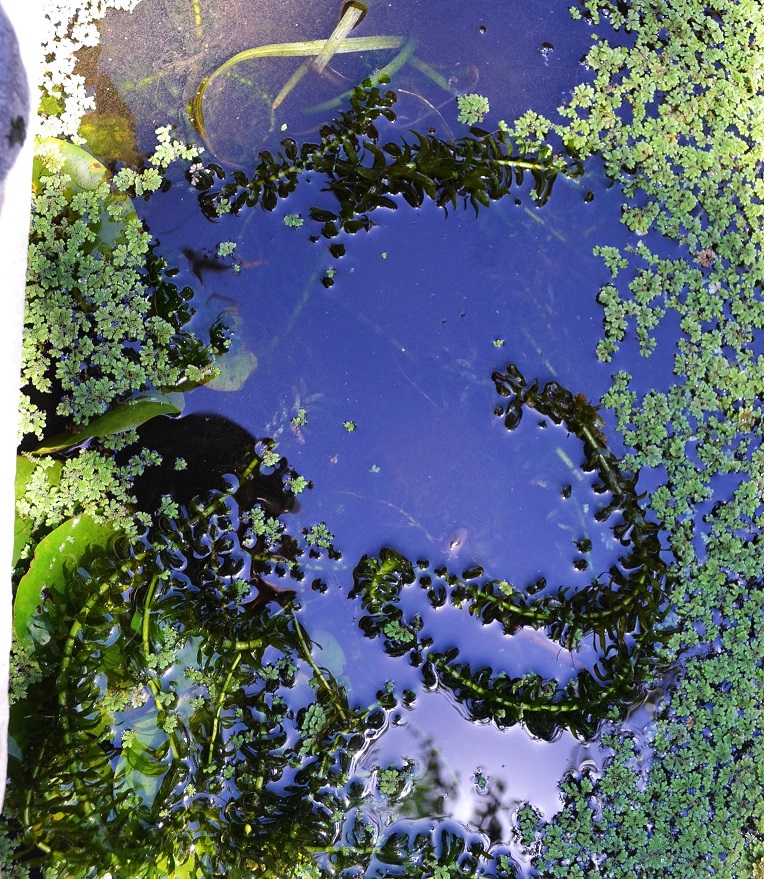
4. Other ornamental marginal/bog plants – to create more height and texture in our pond, we’re also growing a number of ornamental bog plants around the edge, including water papyrus, water lily, flowering water iris and elephant’s ear.
5. Oxygenating plants – as their name suggests, these are plants that grow under the water to help provide oxygen to the fish.
The research suggests that their ‘oxygenating-effect’ is likely to be overrated, but it certainly doesn’t hurt and they provide a good hiding place and rich underwater ecosystem for the fish. We have elodea and ribbon plant (vallisneria), which are hardy and fast growers.
And there you have it – our water wonderland! We hope that reading about our journey inspires you to add a pond or water feature to your garden or, if you already have one, gives you some ideas about how to make it work better for you.
Aw, this was an exceptionally nice post. Spending some time and actual effort to make a top notch article… but what can I say… I procrastinate a lot and never seem to get anything done.
Thank you Carissa, glad you enjoyed it x
Hi there! This post could not be written any better! Looking at this article reminds me of my previous roommate! He constantly kept talking about this. I am going to send this article to him. Fairly certain he will have a good read. I appreciate you for sharing!
Great post! We will be linking to this great article on our website. Keep up the good writing.
Great article and enjoyed immensely. I believe water lettuce (I think it’s also called Nile Cabbage) is edible too but sadly mine died off one very hot summer. I loved that plant and so did all the baby guppies! Where can I buy some – it was a great plant for the froglets when they were leaving the water.